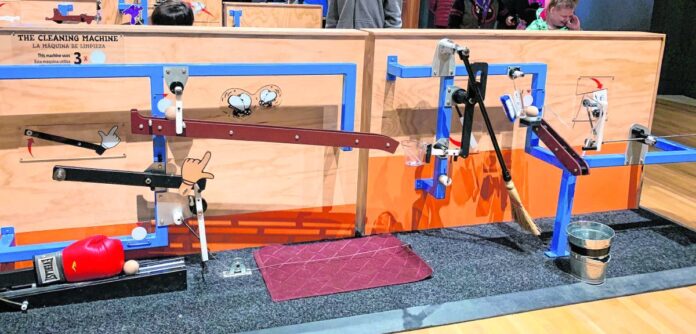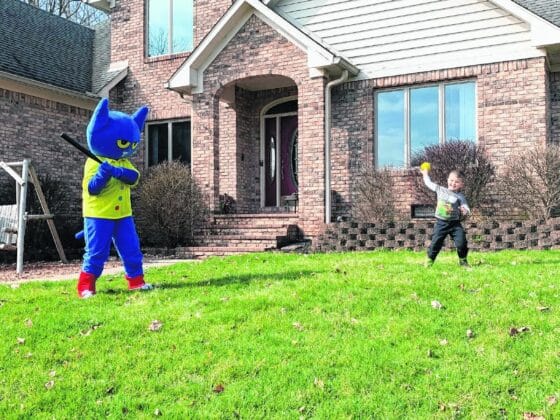If, for some reason, you’re struggling with the concept of cause and effect, get yourself over to the Indiana State Museum and take win “Rube Goldberg: the World of Hilarious Invention.”
Goldberg, a Pulitzer prize-winning cartoonist, drew more than 50,000 cartoons, most of which were sketches of elaborate contraptions designed to perform fairly simple household tasks such as cracking an egg, ringing a bell or pouring a glass of water.
The exhibit at the Indiana State Museum, 650 W. Washington St., features a healthy collection of Rube Goldberg-type machines, drawings by Goldberg and others and some hands-on activities to allow visitors to follow the step-by-step action of chain reaction gadgets.
Since Goldberg was a cartoonist, the exhibit is chock-full of Goldberg’s cartoons, but it also contains the work of Ed Steckley, another Rube Goldberg-style artist. Each example of Steckley’s artwork is shown in three phases: a preliminary sketch; a sketch with letters labeling each step of the chain reaction machine; and finally, the finished product inked and water-colored in.
[sc:text-divider text-divider-title=”Story continues below gallery” ]
One of the most eye-catching displays in the show is a life-sized version of Steckley’s piece, “An Epic Way to Make a Painting.” This corner exhibit features a mix of actual objects (books, furniture, paint, toybox, bookshelf) center-pieced by a life-size ink and watercolor cut-out of the boy starting the machinations to create a painting.
The more than half-a-dozen Rube Goldberg machines are interactive needing a human to pull on the rope or nudge a pool ball or step on a lever to get things going — and to reset the machines after each run. And true to form, each machine only accomplishes one task: to ring a bell, mail a letter or water house plants.
One clever machine had a plunger to pull on, causing a boxing glove to ‘punch’ a wooden ball into action, which eventually resulted in a broom that swept dirt under a rug.
In one corner of the room, on continuous loop, is a music video from the pop group OK Go. While the group sang its song, an elaborate Rube Goldberg machine that began with ubiquitous falling dominoes — and included a tea kettle on a string, a rolling shopping car, a typewriter, a set of chairs falling into each other one at a time, a sledge hammer smashing a TV and a series of globes — resulted in the four members of OK Go getting blasted with paint guns at the end of the song.
Four digital versions of Rube Goldberg machines slowed the action down, allowing visitors to see the real cause and effect. And don’t leave the exhibit without trying your hand at creating a Rube Goldberg variation on the magnetic wall with moveable parts.
Although there is no evidence that Goldberg actually built any of his cartoon contraptions, Rube Goldberg style machines and competitions have become a source of entertainment and creativity for thousands.
Goldberg’s name lives on in the form of many regional competitions and a national competition where the ultimate goal is to go beyond the drawings and create an actual multi-step machine. An annual competition at Purdue University pits teams of engineers against each other to be the group that moves on to the national convention.
Each year’s competition has a new goal: the goal for the 2020 competition is to turn on a light. According to the rules, the machine must incorporate at least 20 steps along the way and its run-time can be no longer than three minutes.
Purdue’s annual contest, recently renamed as the Purdue University National Chain Reaction Competition takes place on the campus on March 2. For more information, visit indianamuseum.org, purdue.edu/newsroom/rubegoldberg/or rubegoldberg.org.






